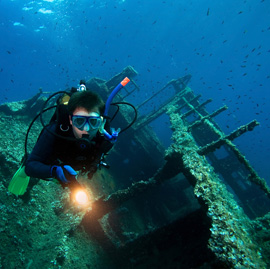Check Yourself Before You Wreck Yourself
Posted: Oct 12 in Dive Blog tagged Deep Diving, Specialty Diving by Jan
An introductory guide to the challenges of wreck diving
Sunken schooners, algae-covered school buses, train cars, fire trucks and telephone booths—manmade treasures like these can make for a ton of underwater fun. Wreck diving gives you the chance to take in some very unusual sights, and the prevalence of these underwater ruins makes them accessible just about anywhere: at the depths of the ocean, in the chill of Lake Michigan and even in some of the Midwest’s limestone quarries.
As is true of any kind of specialty diving, unique precautions need to be made to ensure your safety on a wreck dive. The overhead environment, changing visibility and disorientating nature of wreck diving can make it a challenge, meaning you’ll need to have a firm grasp of advanced dive skills and plenty of experience.
Like cave diving, wreck penetration requires highly specialized equipment and training. However, with basic wreck diving training from a specialty diver class, you can safely tackle the challenges of non-penetration wreck diving at some of our local diving spots.
Gear Up
These pieces of dive equipment can really help you out of a bind while wreck diving:
- Gloves: Jagged, rusty metal is all over the place when exploring the exterior of wrecks. A study pair of gloves will save you from some unwelcome scratches and scrapes as you move across decks and around collapsed deck plates.
- Dive knife. Tangles of rope and snagged fishing lines are commonplace on wrecks and create a very real entanglement hazard. If you become unexpectedly entangled while exploring a wreck, you’ll need a cutting tool that can free you. Bring along something sharp, reliable and easily accessible in case you get snagged.
- Dive light. The ship you’re exploring may have once had electrical lighting and even air conditioning, but these amenities are long gone now. While you won’t be going into a wreck without specialized training, a strong light will allow you to peer into the interior through portholes or doors. Your dive light will also help you see all the colors and details of the aquatic life that now inhabits your sunken destination.
- Dive slate. Navigating a large wreck can be made a little easier if you carry an underwater slate with an outline of the wreck and its main structures marked on it. Knowing where you started the dive and how to get back by navigating to and from visible structures may be more reliable than using a dive compass. Though your dive compass is a valuable tool, you can’t always trust it on a wreck where metal structures may keep it from reliably pointing north.
Have a Plan
As on any dive, you should pay close attention to the dive plan and be sure you (and your buddy) fully grasp the wreck’s conditions and challenges. Depending on the depth of the wreck, you may use lines to get from the surface to the wreck below—this can be a big help in accessing hard-to-reach environments.
Remember your starting point, because this is where your dive will end as well. Staying close to the wreck is generally recommended—this will ensure your safety and help you get a closer look at the tiny organisms that inhabit the wreck. If you stick to the plan, watch out for your buddy and manage your time appropriately, you can reduce the risks of a wreck dive and focus on having fun.
Many of us begin diving to experience the natural beauty of underwater environments, but the sunken structures we encounter underwater are worth exploring as well. Never wreck dive without the proper experience, training and preparation—if you need some guidance, Do Dive In is here to help.
